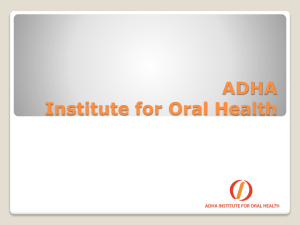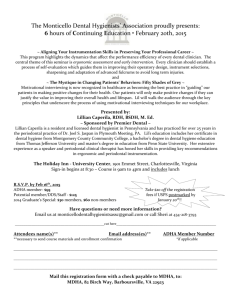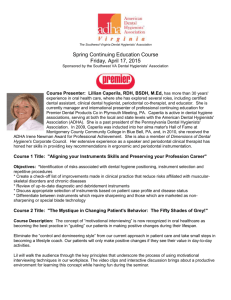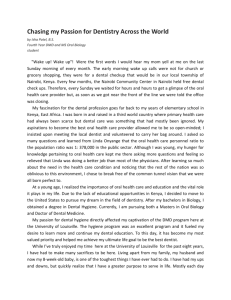Test LeaglEthical
advertisement
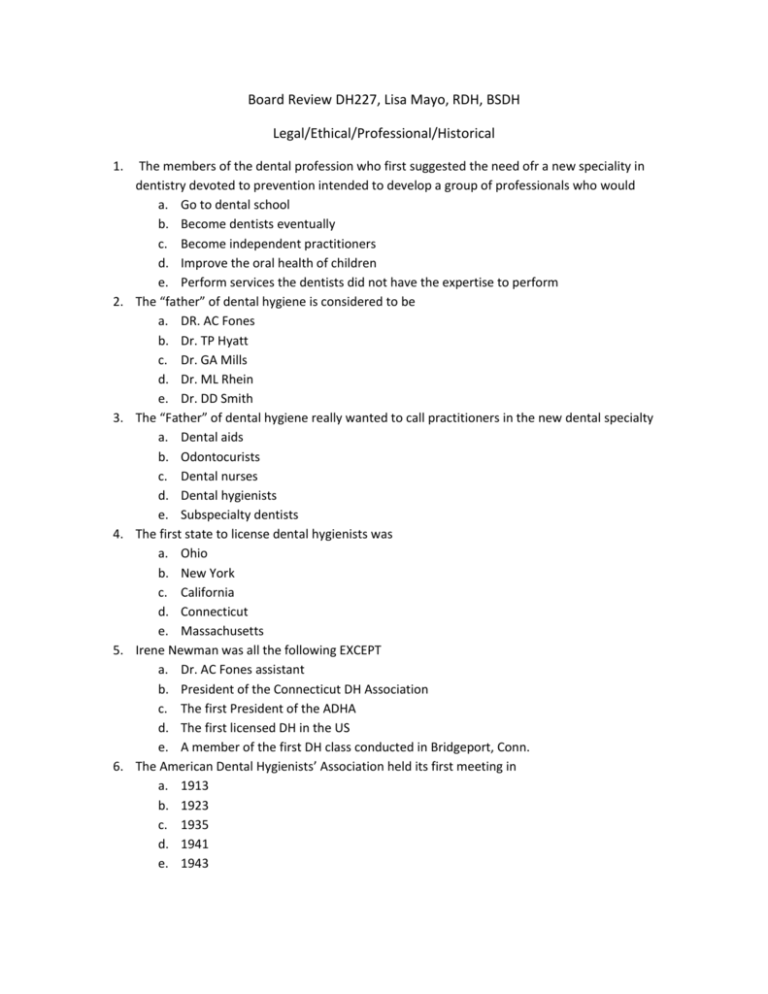
Board Review DH227, Lisa Mayo, RDH, BSDH Legal/Ethical/Professional/Historical 1. 2. 3. 4. 5. 6. The members of the dental profession who first suggested the need ofr a new speciality in dentistry devoted to prevention intended to develop a group of professionals who would a. Go to dental school b. Become dentists eventually c. Become independent practitioners d. Improve the oral health of children e. Perform services the dentists did not have the expertise to perform The “father” of dental hygiene is considered to be a. DR. AC Fones b. Dr. TP Hyatt c. Dr. GA Mills d. Dr. ML Rhein e. Dr. DD Smith The “Father” of dental hygiene really wanted to call practitioners in the new dental specialty a. Dental aids b. Odontocurists c. Dental nurses d. Dental hygienists e. Subspecialty dentists The first state to license dental hygienists was a. Ohio b. New York c. California d. Connecticut e. Massachusetts Irene Newman was all the following EXCEPT a. Dr. AC Fones assistant b. President of the Connecticut DH Association c. The first President of the ADHA d. The first licensed DH in the US e. A member of the first DH class conducted in Bridgeport, Conn. The American Dental Hygienists’ Association held its first meeting in a. 1913 b. 1923 c. 1935 d. 1941 e. 1943 7. During WWII dental hygienists working for the armed forces were given the status of a. Volunteers b. Commissioned officers c. Private practitioners d. Civil service employees e. Noncommissioned officers 8. The Forsyth research project to evaluate the feasibility of dental hygienists performing restorative procedures was terminated because of a. Lack of funding b. Lack of interest c. Opposition of local dentists d. Opposition of the federal government e. Opposition of the citizens of Mass 9. The first dental office of the American Dental Hygienists Association was established in 1948 in a. New York, NY b. Washington DC c. Cleveland, Oh d. Chicago, Il e. Boston, Mass 10. The last state within the continental US to grant dental hygiene licensure was a. Texas b. Maine c. Oregon d. Virginia e. New York 11. Until 1964 one group was excluded from dental hygiene licensure in most states and from membership in the ADHA. This group was made of a. Men b. African Americans c. Women d. Native Americans e. Foreign trained RDHs 12. The office that monitors legislation of interest for the ADHA is the a. Chicago office b. Central office c. New York office d. Washington office e. Bridgeport office 13. The ADHA sponsored the First International Symposium on DH in 1970 in a. Italy b. France c. England d. US e. Australia 14. The Commission on Accreditation of Dental and Dental Auxiliary Programs (now known as the Commission on Dental Accreditation) was established in 1973 by the a. ADA b. Counsel of Allied Health Education c. ADHA d. Counsel on Medical/Dental Education e. American Association of Dental Schools 15. The last state to allow preceptorship training in liue of formal training was a. Texas b. Oregon c. Alabama d. Kentucky e. Massachusetts 16. HYPAC was initiated by 1978 and stands for a. Hygiene Policy Advisory Committee b. Hygiene Planning Alliance Commission c. Hygiene Pilot Articulation Committee d. Hygienist Political Action Committee e. Hygiene Program Accreditation Committee 17. The first state to pass legislation permitting unsupervised practice of DH in all settings was a. California b. Colorado c. Maine d. Oregon e. Washington 18. By 1997, there were approximately 225 DH programs in operation: most of these are in a. Universities b. Proprietary schools c. Academic Health Centers d. Senior Colleges and Institutions e. Community College and Technical Instructions 19. The federal agency that proposed nullification of state restrictions that require DH to wok under supervision of a dentist was the a. Federal Trade Commission b. Counsel of State Governors c. National Institutes of Health d. Department of Health and Human Services e. Dept of Health, Education, Welfare 20. The official Journal of the American DH Association is called a. Directions b. Access c. Dental Hygiene d. Journal of American Dental Hygienist’s Association’ e. Journal of Dental Hygiene 21. The document that describes the mission and goals of the ADHA is the a. Bylaws b. Charter c. Constitution d. Practice Act e. Code of Ethics 22. The detailed rules for governing the ADHA are found in the a. Bylaws b. Charter c. Practice Act d. Constitution e. Code of Ethics 23. The mission of the ADHA includes all the following EXCEPT a. To improve the public’s total health b. To increase awareness of the cost-effective benefits of prevention c. To ensure access to quality oral health care d. To increase the membership of the ADHA to represent the majority of licensed RDHs 24. The Code of Ethics outline the moral obligations of a. The House of Delegates b. The officers of the association only c. The members of boards of dental examiners d. Each individual member of the ADHA e. The ADHA as an organization 25. The policy making body of the ADHA is the a. Central office b. Executive board c. Board of trustees d. Washington office e. House of Delegates 26. There are 2 major functional governing bodies of ADHA: one is responsible for policy and the other for administration. They are the a. Districts and Components b. Constituents and Components c. State and Local Assoc d. Constituents and Counsel of Presidents e. House of Delegates and Board of Trustees 27. The board of trustees of ADHA a. Self-perpetuating b. Appoints the President c. Is the legislative body of the association d. Is presided over by the Speaker of the House e. Is the administration body of the Association 28. The House of Delegates of the ADHA a. Hires the staff b. Reports to the Executive Director c. Is the legislative body of the assoc d. Is the admin body of the assoc e. Conducts the business affairs of the assoc 29. The House of Delegates of the ADHA has the responsibility for all the following EXCEPT a. The election of the President b. Setting the policies of the Assoc c. Approving the budget d. The election of the Speaker of the House e. The amin affairs of the assoc 30. In order to be a member of the ADHA, RDHs must hold membership at each level, with the EXCEPTION of the a. Local level b. District level c. National level d. Component level e. Constituent level 31. An individual, not an RDH, who has gained recognition for contributions to the art and science of DH becomes a a. Allied member of the ADHA b. Active member of the ADHA c. Associate member of the ADHA d. Honorary member of the ADHA e. Retied member of the ADHA 32. The President of the ADHA presides over the Board of Trustees and is a. Elected by district trustees b. Elected by the House of Delegates c. Elected by the general membership d. Appointed by the Board of Trustees e. Appointed by the Executive Director 33. The speaker of the House is elected by the House of Delegates and presides over the a. District meetings b. House of Delegates c. Component meetings d. Counsel of Presidents e. International Liaison Counsel 34. Members of the ADHA have influence over its policies through a. Washington lobbyist b. Trustee representation on the Board of Trustees c. Direct or referendum vote on each issues or policy d. Delegate representation in the House of Delegates e. State Pres, who sits on the counsel of President 35. The Executive Director if responsible for the day-to-day admin operation of the ADHA and is a. Appointed by President b. Elected by membership c. Elected by House of Delegates d. Appointed by Board of Trustees e. Appointed by Counsel of Presidents 36. Members of the ADHA have representation on the Board of Trustees through the district trustee, who is a. Elected by local vote b. Appointed by Pres c. Elected by membership d. Appointed by Executive Director e. Elected by delegates from constituents 37. An appointed official of the ADHA is the a. District Trustee b. VP c. Pres d. Secretary e. Executive Director 38. The study of moral conduct based on theory is known as a. Mores b. Ethics c. Morals d. Values e. Value clarification 39. Valuing a healthy lifestyle is an example of attitudes or beliefs that represent a. Value judgment b. Terminal values c. Intrinsic values d. Extrinsic values e. Instrumental values 40. When personally held values are not congruent with those held by the profession or peers, this may result in a. Value judgment b. Terminal values c. Values dissonance d. A hierarchy of values e. Values clarification 41. Moral reasoning is characterized by a. Mors b. Feelings c. Behavior d. Cognitive judgment e. Beliefs and attitudes 42. In Kohlberg’s hierarchy of moral development the final, or post-conventional, level is reached by a. No adults b. All adults c. Few adults d. All adolescents e. All adolescents and adults 43. In Kohlberg’s hierarchy of moral development, stage 4, the law-and-order orientation, is found in the a. Conventional level b. Preconventional level c. Postconventional level d. Preconventional and conventional levels e. Conventional and postconventional levels 44. If you say “the end justifies the means”, you are thinking as a a. Theorist b. Legalist c. Utilitarian d. Kohlbergian e. Deontologist 45. If you say “it’s the principle of the thing”, you are thinking as a a. Theorist b. Legalist c. Utilitarian d. Kohlbergian e. Deontologist 46. A person who concentrates on principles and rules in general as they apply to types of classes of actions is a(an) a. Legalist b. Act Utilitarian c. Act Deontologist d. Rule Utilitarian e. Rule Deontologist 47. The person who focuses on the outcome of a single act under specific circumstances is a(an) a. Legalist b. Act Utilitarian c. Act Deontologist d. Rule Utilitarian e. Rule Deontologist 48. The principle that states “Above all, do no harm” is the principle of a. Justice b. Autonomy c. Veracity d. Beneficence e. Nonmalefience 49. The ethical principle that required health professionals to fully inform their patients ad protect the confidentiality of the patient is the principle of a. Justice b. Autonomy c. Veracity d. Beneficence e. Nonmalefience 50. When resources are scarce and treatment is allocated only to those who have earned it, this is an example of distributive justice based on a. Need b. Merit c. Equity d. Effort e. Contribution 51. Suppose an RDH performs treatment that is not within the legal limits of DH. Although the patient is not injured by the treatment, this can be considered a. A civil wrong b. A federal crime c. A criminal wrong d. Both civil and criminal wrong e. Neither civil nor criminal wrong 52. Statutory law include all EXCEPT which of the following a. State legislation b. Dental practice acts c. The US Constitution d. Previous court decisions e. Amendments to US Constitution 53. Common law is all EXCEPT which of the following a. Unwritten b. Statutory c. Made by judges d. Based on custom e. Based on previous court decisions 54. A dental professional maybe criminally liable is the tort he or she commits is a. Accidental b. Intentional c. Contributory d. Unintentional e. Caused by negligence 55. The legal area covered by the term tort usually applies to a. Property b. Civil offenses c. Practice agreements d. Contract agreements e. Dental practice acts 56. The act that directly results n injury, and without which the injury would not have occurred, is known in law as a. Res jestae b. Stare decisis c. Proximate cause d. Breech of contract e. Respondeat superior 57. Intentionally defaming someone in writing is known as a. Liable b. Fraud c. Assault d. Slander e. Battery 58. The oral health professionals relationship with individual clients are governed by a. Civil law b. Common law c. Federal law d. Criminal law e. Military law 59. Suppose an RDH, without the employer knowledge, uses the office after hours to render preventive services to a friend and tx results in injury. Who would be held liable? a. Employer b. All 3 parties c. RDH d. Employer and RDH e. Friend under contributory negligence 60. Application of the doctrine of Res Ipsa Loquitor places a burden of proof on a. Court b. Plaintiff c. Defendant d. Expert witness e. Both plaintiff and defendant 61. Suppose an RDH is employed and working for Dr.A, who pays salaries and benefits. She is loaned to Dr.B for a day while Dr.B RDH is out sick. While working in Dr.B office, RDH cuts a patient’s tongue. In addition the RDH, who would be liable a. Dr.A b. Dr.B c. Both Dr’s d. Neither Dr’s e. RDH alone 62. The name given to the principle that a case, once tried, cannot be re-tried for same offense is a. Res gestae b. Res gudicata c. Stare decisis d. Res ipsa loquitur e. Statue of limitations 63. The use of unsterilized instruments renders an oral health care professional liable for malpractice a. Under all circumstances b. If patient contributes to negligence c. If assistant testifies that instruments were unsterile d. If patient injured as a result of unsterile instruments e. If patient sees oral health care professional drop the instrument on floor 64. A physician or dentist is responsible for the negligence of their employee a. At all times b. In the general course of employment c. When in the presence of patients d. Only when carrying out specific instructions e. When the employee acts on his or her own initiative 65. An oral healthcare professional may legally discontinue treatment a. By moving out of town b. Under no circumstances c. By refusing to give further appointments d. By refunding any money collected for the treatment e. By referring the patient to another qualified practitioner 66. The most important question n a malpractice suit is whether the practitioner a. Was experienced b. Had an assistant c. Exercised due care d. Had advanced training e. Had been in practice for 2 years 67. All EXCEPT which of the following must occur in a case of negligence? a. The duty is breached b. A procedure is omitted c. The breach of duty caused the injury d. There is injury to that patient e. There is a duty owed by the practitioner to the patient 68. In a case of proven contributory negligence the a. Court becomes liable b. Parents become liable c. Patient becomes liable d. Health professional remains liable e. Health professional is relived of liability 69. The stature of limitations for bringing a malpractice suit against a practitioner because of a negligent act committed against an adult may a. Be 1 year b. Start at the time injury is discovered c. Be 6yrs d. Be 10yrs e. Be 12yrs 70. A civil complaint may be made by a patient against an oral health professional who performs unauthorized care. Such touching without consent is known as a. Fraud b. Slander c. Battery d. Technical assault e. Breach of contract 71. In law, an acceptable defense against malpractice is a. Good faith b. High ethics c. Reasonable skill and care d. The practitioner’s education e. The practitioner’s reputation 72. In considering the liability of an oral health professional for technical assault, which of the following is MOST relevant? a. There was no charge for the service b. The treatment performed was exploratory c. The patient benefited from the treatment d. The patient had not consented to the treatment e. The oral health professional was well trained and skillful 73. Expressed contracts differ from implied contracts in that expressed contracts a. Are always written b. Have specified terms c. Are not legally binding d. Are general understandings e. Are in effect for only 1 year 74. If a patient is injured because of the negligence of one of two partners a. Both partners are liable b. Neither partner is liable c. Only the partner who caused the injury is liable d. Everyone, including employees of the partnership are liable e. No one is liable because proximate cause cannot be established 75. Dental practice acts regulate the oral health professional’s relationship with the a. State b. Consumer c. Professional association d. Internal Revenue Service e. Federal Trade Commission 76. Dental and DH practice acts are enacted by the a. Local courts b. Federal courts c. State legislatures d. American Dental Association e. State boards of dental examiners 77. The practice of DH is governed in each legal jurisdiction by the Practice Act (statute) and Rules and Regulations. The document that always takes prscendence is the a. Board of Dental Examiners report b. Contract with the employer c. Practice Act d. Rules and Regulations e. Scope of Practice 78. Supervision whereby a licensed dentist authorizes the procedures that are being crried out in accordance with the detnist’s diagnosis and treatment plan but need not be physically present in the dental facility is known as a. Close or indirect supervision b. Direct or immediate supervision c. General supervision d. Personal supervision e. Unsupervised practice 79. The National Board DH Examination is recognized by all the US licensing jurisdictions’ including all 50 states, the District of Columbia, Puerto Rico and Virgin Islands. a. True b. False 80. Which agency is responsible for the development and administration of the National Board of DH Examination? a. ADHA, Commission on National DH Examinations b. ADA, Commission on Dental Accreditation c. ADA, Commission on National Dental Examinations d. Canadian Dental Associations e. State boards of dentistry in each licensing jurisdiction ANSWERS 1.C 2.A 3.D 4.D 5.C 6.B 7.D 8.C 9.B 10.A 11.A 12.D 13.A 14.A 15.C 16.D 17.B 18.E 19.A 20.E 21.C 22.A 23.D 24.D 25.E 26.E 27.E 28.C 29.E 30.B 31.D 32.B 33.B 34.D 35.D 36.E 37.E 38.B 39.E 40.C 41.D 42.C 43.A 44.C 45.E 46.E 47.B 48.E 49.B 50.D 51.C 52.D 53.B 54.B 55.B 56.C 57.A 58.A 59.C 60.C 61.C 62.B 63.D 64.B 65.E 66.C 67.B 68.E 69.B 70.D 71.C 72.D 73.B 74.A 75.A 76.C 77.C 78.C 79.A 80.C
